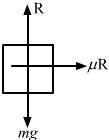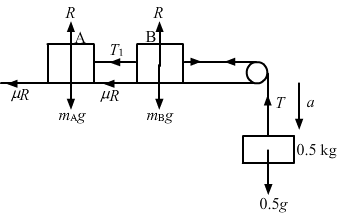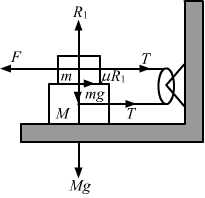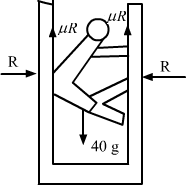HC Verma Physics books are the most preferred books among students of CBSE schools. Students can be found referring to the chapters as well as practice questions at the end of each of these chapters, in the books. Students follow these textbooks religiously since quite a few questions in these also appear in exams.
Contents
- 1 HC Verma Solutions for Class 11 Physics Chapter 6 – Friction
- 1.0.1 Page No 95:
- 1.0.2 Question 1:
- 1.0.3 Answer:
- 1.0.4 Question 2:
- 1.0.5 Answer:
- 1.0.6 Question 3:
- 1.0.7 Answer:
- 1.0.8 Question 4:
- 1.0.9 Answer:
- 1.0.10 Question 5:
- 1.0.11 Answer:
- 1.0.12 Question 6:
- 1.0.13 Answer:
- 1.0.14 Page No 96:
- 1.0.15 Question 7:
- 1.0.16 Answer:
- 1.0.17 Question 8:
- 1.0.18 Answer:
- 1.0.19 Question 9:
- 1.0.20 Answer:
- 1.0.21 Question 10:
- 1.0.22 Answer:
- 1.0.23 Question 11:
- 1.0.24 Answer:
- 1.0.25 Question 1:
- 1.0.26 Answer:
- 1.0.27 Question 2:
- 1.0.28 Answer:
- 1.0.29 Question 3:
- 1.0.30 Answer:
- 1.0.31 Question 4:
- 1.0.32 Answer:
- 1.0.33 Question 5:
- 1.0.34 Answer:
- 1.0.35 Question 6:
- 1.0.36 Answer:
- 1.0.37 Question 7:
- 1.0.38 Answer:
- 1.0.39 Question 8:
- 1.0.40 Answer:
- 1.0.41 Question 9:
- 1.0.42 Answer:
- 1.0.43 Question 10:
- 1.0.44 Answer:
- 1.0.45 Page No 97:
- 1.0.46 Question 1:
- 1.0.47 Answer:
- 1.0.48 Question 2:
- 1.0.49 Answer:
- 1.0.50 Question 3:
- 1.0.51 Answer:
- 1.0.52 Question 4:
- 1.0.53 Answer:
- 1.0.54 Question 5:
- 1.0.55 Answer:
- 1.0.56 Question 1:
- 1.0.57 Answer:
- 1.0.58 Question 2:
- 1.0.59 Answer:
- 1.0.60 Question 3:
- 1.0.61 Answer:
- 1.0.62 Question 4:
- 1.0.63 Answer:
- 1.0.64 Question 5:
- 1.0.65 Answer:
- 1.0.66 Question 6:
- 1.0.67 Answer:
- 1.0.68 Question 7:
- 1.0.69 Answer:
- 1.0.70 Question 8:
- 1.0.71 Answer:
- 1.0.72 Question 9:
- 1.0.73 Answer:
- 1.0.74 Question 10:
- 1.0.75 Answer:
- 1.0.76 Question 11:
- 1.0.77 Answer:
- 1.0.78 Page No 98:
- 1.0.79 Question 12:
- 1.0.80 Answer:
- 1.0.81 Question 13:
- 1.0.82 Answer:
- 1.0.83 Question 14:
- 1.0.84 Answer:
- 1.0.85 Question 15:
- 1.0.86 Answer:
- 1.0.87 Question 16:
- 1.0.88 Answer:
- 1.0.89 Question 17:
- 1.0.90 Answer:
- 1.0.91 Question 18:
- 1.0.92 Answer:
- 1.0.93 Question 19:
- 1.0.94 Answer:
- 1.0.95 Question 20:
- 1.0.96 Answer:
- 1.0.97 Question 21:
- 1.0.98 Answer:
- 1.0.99 Question 22:
- 1.0.100 Answer:
- 1.0.101 Question 23:
- 1.0.102 Answer:
- 1.0.103 Question 24:
- 1.0.104 Answer:
- 1.0.105 Page No 99:
- 1.0.106 Question 25:
- 1.0.107 Answer:
- 1.0.108 Question 26:
- 1.0.109 Answer:
- 1.0.110 Question 27:
- 1.0.111 Answer:
- 1.0.112 Question 28:
- 1.0.113 Answer:
- 1.0.114 Question 29:
- 1.0.115 Answer:
- 1.0.116 Question 30:
- 1.0.117 Answer:
- 1.0.118 Question 31:
- 1.0.119 Answer:
- 2 Chapterwise HC Verma Solutions Class 11 Physics :
- 3 About the Author – HC Verma
HC Verma Solutions for Class 11 Physics Chapter 6 – Friction
For such popular books, students can get extremely helpful practice material online. For all the questions in the HC Verma books, there are several sources where students can get detailed solutions and solve their doubts and queries.
Please note that these solutions are provided here for free.
Page No 95:
Question 1:
For most of the surfaces used in daily life, the friction coefficient is less than 1. Is it always necessary that the friction coefficient is less than 1?
Answer:
It is not necessary that the friction coefficient is always less than 1. When the friction is stronger than the normal reaction force, the coefficient of friction is greater than 1. For example, silicon rubber has the coefficient of friction greater than 1.
Question 2:
Why is it easier to push a heavy block from behind than to press it on the top and push?
Answer:

It is easier to push a heavy block from behind than from the top because when we try to push a heavy block from the top, we increase the normal reaction force, which, in turn, increases the friction between the object and the ground (see the figure).
Question 3:
What is the average friction force when a person has a usual 1 km walk?
Answer:
The person started with zero initial velocity, covered a 1 km distance and ended with zero velocity, so the acceleration is zero. Hence, the average friction force is zero.
Question 4:
Why is it difficult to walk on solid ice?
Answer:
It is difficult to walk on solid ice because the coefficient of friction between our foot and ice is very less; hence, a person trying to walk on solid ice may slip.
Question 5:
Can you accelerate a car on a frictionless horizontal road by putting more petrol in the engine? Can you stop a car going on a frictionless horizontal road by applying brakes?
Answer:
No, we cannot accelerate or stop a car on a frictionless horizontal road. The car will not move on a frictionless surface because rolling is not possible without friction.
Question 6:
Spring fitted doors close by themselves when released. You want to keep the door open for a long time, say for an hour. If you put a half kg stone in front of the open door, it does not help. The stone slides with the door and the door gets closed. However, if you sandwitch a 20 g piece of wood in the small gap between the door and the floor, the door stays open. Explain why a much lighter piece of wood is able to keep the door open while the heavy stone fails.
Answer:
In the first case, the normal reaction force is equal to the weight of the stone, hence the stone slides easily because the friction force is very less. However, in the second case, a small piece of wood is sandwiched, which increases the normal reaction force on the wood due to the weight of the door. Hence, greater the normal reaction force on the wood, the greater will be the frictional force between wood and the floor.
Page No 96:
Question 7:
A classroom demonstration of Newton’s first law is as follows : A glass is covered with a plastic card and a coin is placed on the card. The card is given a quick strike and the coin falls in the glass. (a) Should the friction coefficient between the card and the coin be small or large? (b) Should the coin be light or heavy? (c) Why does the experiment fail if the card is gently pushed?
Answer:
(a) The coefficient of friction between the card and the coin should be small.
(b) The coin should be heavy.
(c) If the card is pushed gently, the experiment fails because the frictional force gets more to time to act and it may gain some velocity and move with the card.
Question 8:
Can a tug of war be ever won on a frictionless surface?
Answer:
No, a tug of war cannot be won on a frictionless surface because the tension in the rope on both the sides of both the teams will be same. So, to win, one of the teams must apply some greater force, which is the force of friction.
Question 9:
Why do tyres have a better grip of the road while going on a level road than while going on an incline?
Answer:
The normal reaction force on a level road is mg, whereas on an inclined plane it is mg cos θ, which means that on an incline road the friction force between the tyre and the road is less. Hence, tyres have less grip on an incline plane and better grip on a level road.
Question 10:
You are standing with your bag in your hands, on the ice in the middle of a pond. The ice is so slippery that it can offer no friction. How can you come out of the ice?
Answer:
By throwing the bag in one direction, we gain some velocity in the opposite direction as per the law of conservation of linear momentum. In this way we can come out of the ice easily.
Question 11:
When two surfaces are polished, the friction coefficient between them decreases. But the friction coefficient increases and becomes very large if the surfaces are made highly smooth. Explain.
Answer:
The coefficient of friction increases between two highly smooth surfaces because the atoms of both the materials come very closer to each and the number of bonds between them increase.
Question 1:
In a situation the contact force by a rough horizontal surface on a body placed on it has constant magnitude. If the angle between this force and the vertical is decreased, the frictional force between the surface and the body will
(a) increase
(b) decrease
(c) remain the same
(d) may increase or decrease.
Answer:
(b) decrease
According to the first law of limiting friction,
f = μN
where f is the frictional force
N is the normal reaction force
μ is the coefficient of static friction
and
N = mg ï¼ Fcosθ
where m is the mass of the body
F is the contact force acting on the body
If we decrease the angle between this contact force and the vertical, then Fcosθ increases and the normal reaction force (N) as well as the frictional force (f) decrease.
Question 2:
While walking on ice, one should take small steps to avoid slipping. This is because smaller steps ensure
(a) larger friction
(b) smaller friction
(c) larger normal force
(d) smaller normal force.
Answer:
(b) smaller friction
According to the first law of the limiting friction,
f = μN
where f is the frictional force
μ is the coefficient of friction
N is the normal reaction force
When we take smaller steps on ice, the normal reaction force exerted by the ice is small. Therefore, the smaller steps ensure smaller friction.
Question 3:
A body of mass M is kept on a rough horizontal surface (friction coefficient = μ). A person is trying to pull the body by applying a horizontal force but the body is not moving. The force by the surface on A is F, where
(a) F = Mg
(b) F = μ Mg
(c) Mg ≤ F ≤ Mg
1+μ2(d) Mg ≥ F ≥ Mg
1-μ2
Answer:
(c) Mg ≤ F ≤ Mg
1+μ2Let T be the force applied on an object of mass M.
If T = 0, Fmin = Mg.
If T is acting in the horizontal direction, then the body is not moving.
∴
T=μ(mg) Fmax =(Mg)2+(T)2 =(Mg)2+(μMg)2Thus, we have:
Mg≤F≤Mg1+(μ)2
Question 4:
A scooter starting from rest moves with a constant acceleration for a time ∆t1, then with a constant velocity for the next ∆t2 and finally with a constant deceleration for the next ∆t3 to come to rest. A 500 N man sitting on the scooter behind the driver manages to stay at rest with respect to the scooter without touching any other part. The force exerted by the seat on the man is
(a) 500 N throughout the journey
(b) less than 500 N throughout the journey
(c) more than 500 N throughout the journey
(d) > 500 N for time ∆t1 and ∆t3 and 500 N for ∆t2.
Answer:
d) >500 N for time ∆t1 and ∆t3 and 500 N for ∆t2.
During the time interval ∆t2, the scooter is moving with a constant velocity, which implies that the force exerted by the seat on the man is 500 N (for balancing the weight of the man).
During the time interval ∆t1 and ∆t3, the scooter is moving with constant acceleration and deceleration, which implies that a frictional force is also applied. Therefore, the net force exerted by the seat on the man should be >500 N.
Question 5:
Consider the situation shown in figure. The wall smooth but the surface of A and B in contact are rough. The friction on B due to A in equilibrium
Figure
(a) is upward
(b) is downward
(c) is zero
(d) the system cannot remain in equilibrium.
Answer:
(d) the system cannot remain in equilibrium.

Since the wall is smooth and the surface of A and B in contact are rough, the net vertical force on the system is in the downward direction. Hence, the system cannot remain in equilibrium.
Question 6:
Suppose all the surface in the previous problem are rough. The direction of friction of B due to A
(a) is upward
(b) is downward
(c) is zero
(d) depends on the masses of A and B.
Answer:
(a) is upward

The normal reaction force on the system (comprising of wall and contact surface of A and B)is provided by F. As can be seen from the figure, the weight of A and B is in the downward direction. Therefore, the frictional force fA and fBA (friction on B due to A) is in upward direction.
Question 7:
Two cars of unequal masses use similar tyres. If they are moving at the same initial speed, the minimum stopping distance
(a) is smaller for the heavier car
(b) is smaller for the lighter car
(c) is same for both cars
(d) depends on the volume of the car.
Answer:
(c) is same for both cars
Given: both the cars have same initial speed.
Let the masses of the two cars be m1 and m2.
Frictional force on car with mass m1 = μm1 g
So, the deceleration due to frictional force =
μm1gm1=μgFrictional force on car with mass m2 = μm2 g
So, the deceleration due to frictional force =
μm2gm2=μgAs both the acceleration are same, from the second equation of motion
s=ut+12at2Thus, we can say that both the cars have same minimum stopping distance.
Question 8:
In order to stop a car in shortest distance on a horizontal road, one should
(a) apply the brakes very hard so that the wheels stop rotating
(b apply the brakes hard enough to just prevent slipping
(c) pump the brakes (press and release)
(d) shut the engine off and not apply brakes.
Answer:
(b) apply the brakes hard enough to just prevent slipping
When we apply hard brakes just enough to prevent slipping on wheels, it provides optimum normal reaction force, which gives the maximum friction force between tyres of the car and the road.
Question 9:
A block A kept on an inclined surface just begins to slide if the inclination is 30°. The block is replaced by another block B and it is found that it just begins to slide if the inclination is 40°.
(a) mass of A > mass of B
(b) mass of A < mass of B
(c) mass of A = mass of B
(d) all of three are possible.
Answer:
(d) all of three are possible.

We know that
N = mg cos θËš
fmax = μN = μmgcos θ
where N = normal reaction force
fmax = frictional force
θ = angle of inclination
μ = coefficient of friction
When the block just begins to slide, it means
mg sin θ = fmax
mg sin θ = μmgcos θ
μ = tan θ
and the coefficient of friction depends on the angle of inclination (θ) and does not depend on mass.
Now consider the block sliding condition:
mg sin θ − fmax = ma
mg sin θ − μmgcos θ = ma
∴ a = g(sin θ − μ cos θ)
From the above equation it is clear that acceleration does not depend on the mass but depends on θ and μ.
Question 10:
A boy of mass M is applying a horizontal force to slide a box of mass M‘ on a rough horizontal surface. The coefficient of friction between the shoes of the boy and the floor is μ and that between the box and the floor is μ’. In which of the following cases it is certainly not possible to slide the box?
(a) μ < μ’, M < M‘
(b) μ > μ’, M < M‘
(c) μ < μ’, M > M‘
(d) μ > μ’, M > M‘
Answer:
(a) μ < μ’, M < M‘
Let T be the force applied by the boy on the block.

Free body diagram for the box:
The condition for preventing the slide is
fmax > T
μ’M’g > T (i)
Now see the free body diagram of a boy of mass M:

fmax = μmg
The condition for preventing the slide is
fmax > T
μmg > T
The condition for sliding the entire system (block and boy) is
f’ > f (block is not slide)
μ’M’g > μmg
μ’M‘ > μm
μ < μ’
m < M’
Page No 97:
Question 1:
Let F, FN and f denote the magnitudes of the contact force, normal force and the friction exerted by one surface on the other kept in contact. If none of these is zero.
(a) F > FN
(b) F > f
(c) FN > f
(d) FN − f < F < FN + f.
Answer:
(a) F > FN
(b) F > f
(d) FN − f < F < FN + f
The system is in equilibrium condition when F = f.
Hence, the net horizontal force is zero.
f = μFN
F > FN
f = FN and 0 ≤ μ ≤ 1
Therefore, we can say that F > f. So the net horizontal force is nonzero.
F > f, and so the net horizontal force is zero.
FN > f
⇒FN > μFN
⇒μ < 1
Here, the given relation between F and f i.e
F > f and f = μFN will not be satisfied So it cannot be said that the net horizontal force is zero or nonzero.
FN − f < F < FN + f
∵ f = μFN
fμ-f<F<fμ+ff1-μμ<F<f1+μμFor the above relation, we can say that F ≠ f and so the net horizontal force is nonzero.
Question 2:
The contact force exerted by a body A on another body B is equal to the normal force between the bodies We conclude that
(a) the surface must be frictionless
(b) the force of friction between the bodies is zero
(c) the magnitude of normal force equal that of friction
(d) the bodies may be rough but they don’t slip on each other.
Answer:
(b) the force of friction between the bodies is zero
(d) the bodies may be rough but they don’t slip on each other
The contact force exerted by a body A on another body B is equal to the normal force between the bodies. Therefore, we can conclude that the force of friction between the bodies is zero or the bodies may be rough but they don’t slip on each other.
Question 3:
Mark the correct statements about the friction between two bodies.
(a) Static friction is always greater than the kinetic friction.
(b) Coefficient of static friction is always greater than the coefficient of kinetic friction.
(c) Limiting friction is always greater than the kinetic friction.
(d) Limiting friction is never less than static friction.
Answer:
(b) Coefficient of static friction is always greater than the coefficient of kinetic friction.
(c) Limiting friction is always greater than the kinetic friction.
(d) Limiting friction is never less than the static friction.
All the above statements are correct. The static friction is sometimes less than the kinetic friction.
Question 4:
A block is placed on a rough floor and a horizontal force F is applied on it. The force of friction f by the floor on the block is measured for different values of F and a graph is plotted between them.
(a) The graph is a straight line of slope 45°.
(b) The graph is a straight line parallel to the F-axis.
(c) The graph is a straight line of slope 45° for small F and a straight line parallel to the F-axis for large F.
(d) There is a small kink on the graph.
Answer:
(c) The graph is a straight line of slope 45° for small F and a straight line parallel to the F-axis for large F.
(d) There is a small kink on the graph.


When force F is appliedon the block, the force of friction f comes into play. As we increase the applied F, the static friction force adjusts itself to become (equal) to the applied force F and goes upto its maximum value equal to limiting friction force.After this ,it is treated as a constant force (i.e . now its value does not change until and unless the body starts moving). If the applied force F is greater than the limiting friction force, then the kinetic friction force comes into play at that time. The kinetic friction force is always less than the limiting friction force.
Question 5:
Consider a vehicle going on a horizontal road towards east. Neglect any force by the air. The frictional force on the vehicle by the road
(a) is towards east if the vehicle is accelerating
(b) is zero if the vehicle is moving with a uniform velocity
(c) must be towards east
(d) must be towards west.
Answer:
(a) is towards east if the vehicle is accelerating
(b) is zero if the vehicle is moving with a uniform velocity
When the vehicle is accelerating, the force is applied (by the tyre on the road) in west direction .That causes a net resultant frictional force acting in east direction. Due to this force of friction only ,the car is moving in east direction.
When the vehicle is moving with a uniform velocity, the force of friction on the wheels of the vehicle by the road is zero.
Question 1:
A body slipping on a rough horizontal plane moves with a deceleration of 4.0 m/s2. What is the coefficient of kinetic friction between the block and the plane?
Answer:
Let m be the mass of the body.

From the free body diagram,
R − mg = 0
(where R is the normal reaction force and g is the acceleration due to gravity)
⇒ R = mg (1)
Again ma − μkR = 0
(where μk is the coefficient of kinetic friction and a is deceleration)
or ma = μkR
From Equation (1),
ma = μkmg
⇒ a = μkg
⇒ 4 = μkg
⇒μk=4g=410=0.4Hence, the coefficient of the kinetic friction between the block and the plane is 0.4.
Question 2:
A block is projected along a rough horizontal road with a speed of 10 m/s. If the coefficient of kinetic friction is 0.10, how far will it travel before coming to rest?
Answer:
Friction force acting on the block will decelerate it.
Let the deceleration be ‘a‘.
Using free body diagram

R − mg = 0
(where R is the normal reaction force)
⇒ R = mg (1)
Again, ma − μkR = 0
(where μk is the coefficient of kinetic friction)
From Equation (1),
⇒ ma = μkmg
⇒ a = μkg = 0.1 × 10
= 1 m/s2
Given:
initial velocity, u = 10 m/s
final velocity, v = 0 m/s (block comes to rest)
a = −1 m/s2 (deceleration)
Using equation of motion v2
–u2 = 2as
(where s is the distance travelled before coming to rest)
s=v2-u22aOn substituting the respective values, we get
=0-1022 -1 =1002=50 mTherefore, the block will travel 50 m before coming to rest.
Question 3:
A block of mass m is kept on a horizontal table. If the static friction coefficient is μ, find the frictional force acting on the block.
Answer:
A block of mass m is kept on a horizontal table. If force is applied on the block, a friction force will be there: p → frictional force and F → applied force

So, friction force is equal to the applied force. One of the case is that the friction force is equals to zero when the applied force is equal to zero.
Question 4:
A block slides down an inclined surface of inclination 30° with the horizontal. Starting from rest it covers 8 m in the first two seconds. Find the coefficient of kinetic friction between the two.
Answer:
Free body diagram for the block is as follows:
From the above diagram:
R − mg cos θ = 0
⇒ R = mg cos θ (1)
For the block, u = 0 m/s, s = 8 m and t = 2 s.
According to the equation of motion
s=ut+12at2
s=0+12a228=2aa = 4 m/s2
Again,
μkR + ma − mg sin θ = 0
(where μk is the coefficient of kinetic friction)
From Equation (1):
μkmg cos θ + ma − mg sin θ = 0
⇒ m (μkg cos θ + a − g sin θ) = 0
⇒ μk × 10 × cos 30° = g sin 30° − a
⇒μk×1032=10×12-4⇒53μk=1⇒μk=153=0.11Therefore, the coefficient of kinetic friction between the block and the surface is 0.11.
Question 5:
Suppose the block of the previous problem is pushed down the incline with a force of 4 N. How far will the block move in the first two seconds after starting from rest? The mass of the block is 4 kg.
Answer:
Free body diagram of the block for this case is as follows:

From the adove diagram:
F − ma − μkR + mg sin 30° = 0
4 − 4a − μkR + 4g sin 30° = 0 (1)
R − 4g cos 30° = 0 (2)
⇒ R = 4g cos 30° = 0
Substituting the values of R in Equation (1) we get
4 − 4a− 0.11 × 4g cos 30° + 4g sin 30° = 0
⇒4-4a-0.11×4×10×32+4×10×12=04 − 4a − 3.81 + 20 = 0
4 − 4a − 3.18 + 20 = 0
a ≈ 5 m/s2
For the block, u = 0, t = 2 s and a = 5 m/s2.
According to the equation of motion,
​ ​
s=ut+12at2
=0+125×22=10 mTherefore, the block will move 10 m.
Question 6:
A body of mass 2 kg is lying on a rough inclined plane of inclination 30°. Find the magnitude of the force parallel to the incline needed to make the block move (a) up the incline (b) down the incline. Coefficient of static friction = 0.2.
Answer:
(a) To make the block move up the incline, the applied force should be equal and opposite to the net force acting down the incline.
Applied force = μR + 2g sin 30° (1)
(where μ is the coefficient of static friction)
R = mg cos 30°
Substituting the respective values in Equation (1), we get
=0.2×9.83+2×9.8×123.39 + 9.8
≈13 N

With this minimum force, the body moves up the incline with a constant velocity as the net force on it is zero.
(b) Net force acting down the incline is given by
F = 2g sin 30° − μR

=2×9.8×12-3.99=6.41 NBecause F = 6.41 N, the body will move down the incline with acceleration, hence the force required is zero.
Question 7:
Repeat part (a) of problem 6 if the push is applied horizontally and not parallel to the incline.
Answer:
Using the free body diagram,

g = 10 m/s2, m = 2 kg, θ = 30 and μ = 0.2
R − mg cos θ − F sin θ = 0
⇒ R = mg cos θ + F sin θ (1)
and
mg sin θ + μR − F cos θ = 0
⇒ mg sin θ + μ(mg cos θ + F sin θ) − F cos θ = 0
⇒ mg sin θ + μmg cos θ + μF sin θ − F cos θ = 0
⇒F=mg sin θ+μ mg cos θμ sin θ-cos θ (θ=30°) =2×10×12+0.2×2×10×320.2×12-32 =13.4640.76=17.7 N=17.5 NTherefore, while pushing the block to move up on the incline, the required force is 17.5 N.
Question 8:
In a children-park an inclined plane is constructed with an angle of incline 45° in the middle part (figure 6−E1). Find the acceleration of boy sliding on it if the friction coefficient between the cloth of the boy and the incline is 0.6 and g = 19 m/s2.
Figure
Answer:
Let m be the mass of the boy.

From the above diagram:
R − mg cos 45° = 0
R=mg cos 45°=mg2 1Net force acting on the boy, making him slide down
= mg sin 45° − μR
= mg sin 45° − μmg cos 45°
=m×10×12-0.6×m×10×12=m52-32=m×2×2The acceleration of the boy
=ForceMass
=m22m=22 m/s2
Question 9:
A body starts slipping down an incline and moves half metre in half second. How long will it take to move the next half metre?
Answer:
Let a be the acceleration of the body sliding down.

From the above diagram:
R − mg cos θ = 0
⇒ R = mg cos θ (1)
and
ma + mg sin θ − μR = 0
⇒
a=mg(sinθ-μ cosθ)m=g(sinθ-μ cosθ)For the first half metre, u = 0, s = 0.5 m and t = 0.5 s.
According to the equation of motion,
v = u + at
= 0 + (0.5)4 = 2 m/s
s=ut+12at2
0.5=0+12a0.52⇒a=4 m/s2For the next half metre, u = 2 m/s, a = 4 m/s2 and s = 0.5.
⇒0.5=2t+124t2⇒ 2t2 + 2t − 0.5 = 0
⇒ 4t2 + 4t − 1 = 0
⇒t=-4±16+162×4 =1.6568=0.2027Therefore, the time taken to cover the next half metre is 0.21 s.
Question 10:
The angle between the resultant contact force and the normal force exerted by a body on the other is called the angle of friction. Show that, if λ be the angle of friction and μ the coefficient of static friction λ ≤ tan−1 μ.
Answer:
Let
f be the applied force,
R be the normal reaction force and
F be the frictional force.

The coefficient of static friction is given by
u=tan λ=FR(where λ is the angle of friction)
When F = μR, F is the limiting friction (maximum friction). When applied force increases and the body still remains still static then the force of friction increases up to its maximum value equal to limiting friction (μR).
F<μR∴tan λ=FR≤μRR⇒ tan λ ≤ μ
⇒ λ ≤ tan−1 μ
Question 11:
Consider the situation shown in figure (6−E2). Calculate (a) the acceleration of the 1.0 kg blocks, (b) the tension in the string connecting the 1.0 kg blocks and (c) the tension in the string attached to 0.50 kg.
Figure
Answer:

From the above diagrams:
T + ma − mg = 0
T + 0.5a − 0.5 g = 0 (1)
μR + ma + T1 − T = 0
μR + 1a + T1 − T = 0 (2)
μR + 1a − T1 = 0
μR + a = T1 (3)
From Equations (2) and (3) we have
μR + a = T − T1
⇒ T − T1 = T1
⇒ T = 2T1
So, Equation (2) becomes
μR + a + T1 − 2T1 = 0
⇒ μR + a − T1 = 0
⇒ T1 = μR + a
= 0.2g + a (4)
and Equation (1) becomes
2T1 + 0.5a − 0.5g = 0
⇒T1=0.5g-0.5a2 =0.25g-0.25a (5)From Equations (4) and (5)
0.2g + a = 0.25g − 0.25a
⇒a=0.051.25×10 =0.4×10 m/s2 g=10 m/s2Therefore,
(a) the acceleration of each 1 kg block is 0.4 m/s2,
(b) the tension in the string connecting the 1 kg blocks is
T1 = 0.2g + a + 0.4 = 2.4 N
​ and
(c) the tension in the string attached to the 0.5 kg block is
T = 0.5g − 0.5a
= 0.5 × 10 − 0.5 × 0.4
= 4.8 N.
Page No 98:
Question 12:
If the tension in the string in figure (6−E3) is 16 N and the acceleration of each block is 0.5 m/s2, find the friction coefficients at the two contact with the blocks.
Figure
Answer:
From the free body diagram:
μ1R + m1a − F = 0
μ1R + 1 − 16 = 0 (R = mg cos θ)

⇒ μ1(2g) + (−15) = 0
μ1=1520=0.75Again,
μ2R1 + ma = F − mg sin θ = 0
μ2R1 + 4 × 0.5 = 16 − 4g sin 30° = 0
R1 = mg cos θ (θ = 30°)
⇒μ2203+2+16-20=0⇒μ2=2203=117.32 =0.057=0.06Therefore, the friction coefficients at the two contacts with blocks are
μ1 = 0.75 and μ2 = 0.06.
Question 13:
The friction co-efficient between the table and the block shown in figure (6−E4) is 0.2. Find the tensions in the two strings.
Figure
Answer:

Consider that a 15 kg object is moving downward with an acceleration a.
From the above diagram,
T + m1a − m1g = 0
T + 15a − 15g = 0
⇒ T = 15g − 15a (1)
Now,
T1 − m2g − m2a = 0
T1 − 5g − 5a = 0
⇒ T1 = 5g + 5a (2)
Again,
T − (T1 + 5a + m2R) = 0
⇒ T − (5g + 5a + 5a +m2R) = 0 (3)
(where R = μg)
From Equations (1) and (2),
15g − 15a = 5g + 10a + 0.2 (5g)
⇒ 25a = 90 [g = 10 m/s2]
⇒ a = 3.6 m/s2
From Equation (3),
T = 5 × 10 + 10 × 3.6 + 0.2 × 5 × 10 = 96 N in the left string.
From Equation (2),
T1 = 5g + 5a
= 5 × 10 + 5 × 36
= 50 + 18
= 68 N in the right string.
Question 14:
The friction coefficient between a road and the type of a vehicle is 4/3. Find the maximum incline the road may have so that once had brakes are applied and the wheel starts skidding, the vehicle going down at a speed of 36 km/hr is stopped within 5 m.
Answer:
Given,
initial velocity of the vehicle, u = 36 km/h = 10 m/s
final velocity of the vehicle, v = 0
s = 5 m,
μ=43, g = 10 m/s2
Let the maximum angle of incline be
θ.
Using the equation of motion
a=v2-u22s=0-1022×5 =-10 m/s2From the free body diagram
R − mg cos θ = 0
⇒ R = mg cos θ (1)
Again,
ma + mg sin θ − μ R = 0
⇒ ma + mg sin θ − μmg cos θ = 0
⇒ a + g sin θ − μg cos θ = 0
⇒10+10 sin θ-43×10 cos θ=0⇒ 30 + 30 sin θ − 40 cos θ = 0
⇒ 3 + 3 sin θ − 4 cos θ = 0
⇒ 4 cos θ − 3 sin θ = 3
⇒41-sin2 θ=3+3 sin θOn squaring, we get
16 (1 − sin2 θ) = 9 + 9 sin2 θ + 18 sin θ
25 sin2 θ + 18 sin θ − 7 = 0
⇒sin θ=18+182-425 -72×25 =-18+3250=1450=0.28 Taking positve sign only⇒θ=sin-1 0.28=16°Therefore, the maximum incline of the road, θ = 16°.
Question 15:
The friction coefficient between an athelete’s shoes and the ground is 0.90. Suppose a superman wears these shoes and races for 50 m. There is no upper limit on his capacity of running at high speeds. (a) Find the minimum time that he will have to take in completing the 50 m starting from rest. (b) Suppose he takes exactly this minimum time to complete the 50 m, what minimum time will he take to stop?
Answer:
To reach the 50 m distance in minimum time, the superman has to move with maximum possible acceleration.
Suppose the maximum acceleration required is ‘a‘.
∴ ma − μR = 0 ⇒ ma = μ mg
⇒ a = μg = 0.9 × 10 = 9 m/s2
(a) As per the question, the initial velocity,
u = 0, t = ?
a = 9 m/s2, s = 50 m
From the equation of motion,
s=ut+12at2
50=0+129t2⇒t=103 s(b) After covering 50 m, the velocity of the athelete is
v = u + at
=0+9×103 m/s=30 m/sThe superman has to stop in minimum time. So, the deceleration, a = − 9 m/s2 (max)
R = mg
ma = μR (maximum frictional force)
ma = μmg
⇒ a = μg
= 9 m/s2 (deceleration)
u1 = 30 m/s, v = 0
⇒t=v1-u1a =0-30-a =-30-a=103 s
Question 16:
A care is going at a speed of 21.6 km/hr when it encounters at 12.8 m long slope of angle 30° (figure 6−E5). The friction coefficient between the road and the tyre is
1/23. Show that no matter how hard the driver applies the brakes, the car will reach the bottom with a speed greater than 36 km/hr. Take g = 10 m/s2.
Figure
Answer:
When the driver applies hard brakes, it signifies that maximum force of friction is developed between the tyres of the car and the road.
So, maximum frictional force = μR
From the free body diagram,
R − mg cos θ = 0
⇒ R = mg cos θ (1)
and
μR + ma − mg sin θ = 0 (2)
⇒ μ mg cos θ + ma − mg sin θ = 0

where θ = 30Ëš
⇒μg cos θ+a-10×12=0⇒a=5-123×1032 =5-10×34 =204-10×34 =-104 =-2.5 m/s2s = 12.8 m
u = 6 m/s
∴ Velocity at the end of incline
ν=u2+2as =62+22.5 12.8 =36+64 =10 m/s=36 km/hTherefore, the harder the driver applies the brakes, the lower will be the velocity of the car when it reaches the ground, i.e. at 36 km/h.
Question 17:
A car starts from rest on a half kilometre long bridge. The coefficient of friction between the tyre and the road is 1.0. Show that one cannot drive through the bridge in less than 10 s.
Answer:
Let a be the maximum acceleration of the car for crossing the bridge.

From the above diagram,
ma = μR
(For more accelerations the tyres will slip)
ma = μmg
a = μg = 1 × 10 = 10 m/s2
To cross the bridge in minimum possible time, the car must be at its maximum acceleration.
u = 0, s = 500 m, a = 10 m/s2
From the equation of motion,
s=ut+12at2Substituting respective values
500=0+1210t2⇒t=100=10 sTherefore, if the car’s acceleration is less than 10 m/s2, it will take more than 10 s to cross the bridge. So, one cannot drive through the bridge in less than 10 s.
Question 18:
Figure (6−E6) shows two blocks in contact sliding down an inclined surface of inclination 30°. The friction coefficient between the block of mass 2.0 kg and the incline is μ1, and that between the block of mass 4.0 kg and incline is μ2. Calculate the acceleration of the 2.0 kg block if (a) μ1 = 0.20 and μ2 = 0.30, (b) μ1 = 0.30 and μ2 = 0.20. Take g = 10 m/s2.
Figure
Answer:

(a) From the free body diagram

R = 4g cos 30°
⇒R=4×10×32 =203 N 1μ2R + m1a − p − m1g sin θ = 0
μ2R + 4a − p − 4g sin 30° = 0
⇒ 0.3
× (40) cos 30° + 4a − p − 40 sin 30° = 20 (2)

R1 = 2g cos 30°
=103 (3)
p + 2a − μ1R1 − 2g sin 30° = 0 (4)
From Equation (2),
63+4a-p-20=0From Equation (4),
p+2a+23-10=1063+6a+30+23=0⇒6a=30-83 =30-13.85=16.15⇒a=16.156 =2.69=2.7 m/s2(b) In this case, the 4 kg block will move at a higher acceleration because the coefficient of friction is less than that of the 2 kg block. Therefore, the two blocks will move separately. By drawing the free body diagram of 2 kg mass, it can be shown that a = 2.4 m/s2.
Question 19:
Two masses M1 and M2 are connected by a light rod and the system is slipping down a rough incline of angle θ with the horizontal. The friction coefficient at both the contacts is μ. Find the acceleration of the system and the force by the rod on one of the blocks.
Answer:
From the free body diagram

R1 = M1g cos θ (1)
R2 = M2g cos θ (2)
T + M1g sin θ − M1a − μR1 = 0 (3)
T − M2g + M2a + μR2 = 0 (4)
From Equation (3),
T + M1g sin θ − M1 a − μM1g cos θ = 0 (5)
From Equation (4),
T − M2 g sin θ + M2 a + μM2 g cos θ = 0 (6)
From Equations (5) and (6),
g sin θ(M1 + M2) − a(M1 + M2) − μg cos θ(M1 + M2)
⇒ a(M1 + M2) = g sin θ(M1 + M2) = μg cos θ(M1 + M2)
⇒ a = g(sin θ − μ cos θ)a − g(sin θ − μ cos θ)
∴ The acceleration of the block (system) = g(sin θ − μcos θ)
The force exerted by the rod on one of the blocks is tension, T.
T = −M1gsin θ + M1a + μM1g cos θ
T = −M1g sin θ + M1(g sin θ − μg cos θ) + μM1g cos θ = 0
Question 20:
A block of mass M is kept on a rough horizontal surface. The coefficient of static friction between the block and the surface is μ. The block is to be pulled by applying a force to it. What minimum force is needed to slide the block? In which direction should this force act?
Answer:
Let P be the force applied to slide the block at an angle θ.

From the free body diagram,
R + P sin θ − mg = 0
⇒ R = −P sin θ + mg (1)
μR = P cos θ (2)
From Equation (1),
μ(mg − P sin θ)−P cos θ = 0
⇒ μmg = μP sin θ + P cos θ
⇒P=μ mgμ sin θ+cos θThe applied force P should be minimum, when μ sin θ + cos θ is maximum.
Again, μ sin θ + cos θ is maximum when its derivative is zero:
ddθμ sin θ+cos θ=0⇒ μ cos θ − sin θ = 0
θ = tan−1 μ
So,
P=μ mgμ sin θ+cos θDividing numerator and denominator by cos θ, we get
=μ mg/cos θμ sin θcos θ+cos θcos θ P=μ mg sec θ1+μ tan θ =μ mg sec θ1+tan2 θ=μ mgsec θ =μ mg1+tan2 θ=μ mg1+μ2(using the property
1+tan2θ=sec2θ)
Therefore, the minimum force required is
μ mg1+μ2 at an angle θ = tan−1 μ.
Question 21:
The friction coefficient between the board and the floor shown in figure (6−E7) is μ. Find the maximum force that the man can exert on the rope so that the board does not slip on the floor.
Figure
Answer:
Let T be the maximum force exerted by the man on the rope.
From the free body diagram,
R + T = Mg
⇒ R = Mg − T (1)
Again,
R1 − R − mg = 0
⇒ R1 = R + mg (2)
and
T − μR1 = 0
From Equation (2),
T − μ(R + mg) = 0
⇒ T − μR − μ mg = 0
⇒ T − μ(Mg − T) − μmg = 0
T − μMg + μt − μmg = 0

⇒ T (1 + μ) = μMg + μmg
⇒T=μ M+mg1+μTherefore, the maximum force exerted by the man is
μM+mg1+μ.
Question 22:
A 2 kg block is placed over a 4 kg block and both are placed on a smooth horizontal surface. The coefficient of friction between the block is 0.20. Find the acceleration of the two blocks if a horizontal force of 12 N is applied to (a) the upper block, (b) the lower block. Take g = 10 m/s2.
Answer:

Consider the free body diagram.
(a) For the mass of 2 kg, we have:
R1 − 2g = 0
⇒ R1 = 2 × 10 = 20
2a + 0.2 R1 − 12 = 0
⇒ 2a + 0.2 (20) = 12
⇒ 2a = 12 − 4
⇒ a = 4 m/s2
Now,
4a − μR1 = 0
⇒ 4a = μR1 = 0.2 (20) = 4
⇒ a1 = 1 m/s2

The 2 kg block has acceleration 4 m/s2 and the 4 kg block has acceleration 1 m/s2.
(ii) We have:
R1 = 2g = 20
Ma = μR1 = 0
a = 0
And,
Ma + μmg − F = 0
4a + 0.2 × 2 × 10 − 12 = 0
⇒ 4a + 4 = 12
⇒ 4a = 8
⇒ a = 2 m/s2
Question 23:
Find the accelerations a1, a2, a3 of the three blocks shown in figure (6−E8) if a horizontal force of 10 N is applied on (a) 2 kg block, (b) 3 kg block, (c) 7 kg block. Take g = 10 m/s2.
Figure
Answer:
Given:
μ1 = 0.2
μ2 = 0.3
μ3 = 0.4
Using the free body diagram, we have:

(a) When the 10 N force is applied to the 2 kg block, it experiences maximum frictional force.
Here,
μ1R1 = μ1 × m1g
μ1R1 = μ1 × 2g = (0.2) × 20
= 4 N (From the 3 kg block)
Net force experienced by the 2 kg block = 10 − 4 = 6 N
∴
a1=62=3 m/s2But for the 3 kg block (Fig. 3), the frictional force from the 2 kg block, i.e, 4 N, becomes the driving force and the maximum frictional force between the 3 kg and 7 kg blocks.
Thus, we have:
μ2 = R2 = μ2m2g = (0.3) × 5 kg
= 15 N
Therefore, the 3 kg block cannot move relative to the 7 kg block.
The 3 kg block and the 7 kg block have the same acceleration (a2 = a3), which is due to the 4 N force because there is no friction from the floor.
∴a2=a3=410=0.4 m/s2(b) When the 10 N force is applied to the 3 kg block, it experiences maximum frictional force of (15 + 4) N, i.e., 19 N, from the 2 kg block and the 7 kg block.
So, it cannot move with respect to them.
As the floor is frictionless, all the three bodies move together.
∴a1=a2=a3=1012=56 m/s2(c) Similarly, it can be proved that when the 10 N force is applied to the 7 kg block, all three blocks move together with the same acceleration.
∴ a1=a2=a3=56 m/s2
Question 24:
The friction coefficient between the two blocks shown in figure (6−E9) is μ but the floor is smooth. (a) What maximum horizontal force F can be applied without disturbing the equilibrium of the system? (b) Suppose the horizontal force applied is double of that found in part (a). Find the accelerations of the two masses.
Figure
Answer:

From the free body diagrams of the two blocks, we have
R1 = mg …(i)
F = μR1+T …(ii)
T − μR1 = 0 ..(iii)
From equations (i) and (ii), we have
F − μmg = T …(ii)
From equations (i) and (iii), we have
T = μmg
Putting T = μmg in equation (ii), we have
F = μmg + μmg = 2μmg

(b) From the free body diagram of upper block, we have
2F − T − μmg = ma ….(i)
From the free body diagram of lower block, we have
T = Ma + μmg
Putting the value of T in (i), we get
2F − Ma − μmg − μmg = ma
Putting F = 2μmg, we get
2(2μmg) − 2μmg = a(M + m)
⇒ 4μmg − 2μmg = a(M + m)
⇒a=2 μmgM+m in opposite directions.
Page No 99:
Question 25:
Suppose the entire system of the previous questions is kept inside an elevator which is coming down with an acceleration a < g. Repeat parts (a) and (b).
Answer:

From the free body diagram, we have:
R1 + ma − mg = 0
⇒ R1 = m (g − a)
= mg − ma …(i)
Now,
F − T − μR1 = 0 and
T − μR1 = 0
⇒ F − [μ (mg − ma)] − μ(mg − ma) = 0
⇒ F − μ mg − μma − μmg + μma = 0
⇒ F = 2 μmg − 2 μma
= 2 μm (g − a)
(b) Let the acceleration of the blocks be a1.
R1 = mg − ma ….(i)
And,
2F −T − μR1 = ma1 …(ii)
Now,
T = μR1 + Ma1
= μmg − μma + Ma1
Substituting the value of F and T in equation (ii), we get:
2[2μm(g − a)] − (μmg − μma + Ma1) − μmg + μma = ma1
⇒ 4μmg − 4μma − 2μmg + 2μma= ma1 + Ma1
⇒a1=2μm g-aM+mThus, both the blocks move with same acceleration a1 but in opposite directions.
Question 26:
Consider the situation shown in figure (6−E9). Suppose a small electric field E exists in the space in the vertically charge Q on its top surface. The friction coefficient between the two blocks is μ but the floor is smooth. What maximum horizontal force F can be applied without disturbing the equilibrium?
[Hint: The force on a charge Q bye the electric field E is F = QE in the direction of E.]
Answer:
From the free body diagram:

R1 + QE − mg = 0
where
R1 is the normal reaction force
Q is the charge
E is the small electric field
⇒ R1 = mg − QE (1)
F − T − μR1 = 0
F − T = μR1
where F is the maximum horizontal force required
From Equation (1),
F − T − μ(mg − QE) = 0
F − T = μ(mg − QE)
⇒ F − T − μmg + μQE = 0 (2)
T − μR1 = 0
⇒ T = μR1 = μ (mg − QE) (3)
From Equation (2),
F − μmg + μ QE − μmg + μQE = 0
⇒ F − 2 μmg + 2μQE = 0
⇒ F = 2μmg − 2μQE
⇒ F = 2μ (mg − QE)
Therefore, the maximum horizontal force that can be applied is 2μ (mg − QE).
Question 27:
A block of mass m slips on a rough horizontal table under the action of a horizontal force applied to it. The coefficient of friction between the block and the table is μ. The table does not move on the floor. Find the total frictional force applied by the floor on the legs of the table. Do you need the friction coefficient between the table and the floor or the mass of the table?
Figure
Answer:
When a block slips on a rough horizontal table, the maximum frictional force acting on it can be found from the free body diagram (see below).
R = mg
(i) (ii)
(ii) 
From the free body diagram,
F − μR = 0
⇒ F = μR = μmg
But the table is at rest, so the frictional force at the legs of the table is also μR. Let this be f, so from the free body diagram
f − μR = 0
⇒ f = μR = μmg
Therefore, the total frictional force on the table by the floor is μmg.
Question 28:
Find the acceleration of the block of mass M in the situation of figure (6−E10). The coefficient of friction between the two blocks is μ1 and that between the bigger block and the ground is μ2.
Answer:
Let us the acceleration of the block of mass M be a and let it be towards right. Therefore, the block of mass m must go down with acceleration 2a. As both the blocks are in contact, it (block of mass m) will also have acceleration a towards right. Hence, it will experience two inertial forces as shown in the free body diagram given below.
(Free body diagram 1)
From the free body diagram 1, we have:
(Free body diagram-2)
R1 − ma = 0
⇒ R1 = ma ….(i)
Again,
2ma + T − Mg + μ1R1 = 0
⇒ T = Mg − (2 + μ1) ma ….(ii)
Using the free body diagram 2, we have:
T + μ1R1 + Mg − R2 = 0
Substituting the value of R1 from (i), we get:
R2 = T + μ1 ma + mg
Substituting the value of T from (ii), we get:
R2 = (Mg − 2ma − μ1ma) = μ1 ma + Mg + ma
∴ R2 = Mg + Ma − 2ma ….(iii)
Again using the free body diagrams −2,
T + T − R − Ma − μ2R2 = 0
⇒ 2T − Ma − ma − μ2(Mg + mg − 2ma) = 0
Substituting the values of R1 and R2 from (i) and (iii), we get:
2T = (M + m)a + μ2 (Mg + mg − 2ma) ….(iv)
From equations (ii) and (iv), we have:
2T = 2mg − 2(2 + μ1) ma
= (M + m) a + μ1(Mg + mg − 2ma)
⇒ 2mg − μ2 (M + m)g = a[M + m − 2μ2m + 4m + 2μ1m]
Therefore, the acceleration of the block of mass M in the given situation is given by
a=2m+m2M+mgM+m5+2μ1-μ2
Question 29:
A block of mass 2 kg is pushed against a rough vertical wall with a force of 40 N, coefficient of static friction being 0.5. Another horizontal force of 15 N, is applied on the block in a direction parallel to the wall. Will the block move? If yes, in which direction? If no, find the frictional force exerted by the wall on the block.
Answer:
Net force on the block
=202+152-0.5×40 = 25 − 20 = 5 N
∴tan θ=2015=43⇒θ=tan-143=53°Therefore, the block will move at 53° angle with the 15 N force.
Question 30:
A person (40 kg) is managing to be at rest between two vertical walls by pressing one wall A by his hands and feet and the other wall B by his back (figure 6−E11). Assume that the friction coefficient between his body and the walls is 0.8 and that limiting friction acts at all the contacts. (a) Show that the person pushes the two wall with equal force. (b) Find the normal force exerted by either wall on the person. Take g = 10 m/s2.
Figure
Answer:

Thus, we have:
μR + μR = mg
⇒ 2μR = 40 × 10
⇒R=40×102×0.8=250 NNormal force = 250 N
Question 31:
Figure (6−E12) shows a small block of mass m kept at the left end of a larger block of mass M and length l. The system can slide on a horizontal road. The system is started towards right with an initial velocity v. The friction coefficient between the road and the bigger block is μ and that between the block is μ/2. Find the time elapsed before the smaller blocks separates from the bigger block.
Figure
Answer:
Let a1 and a2 be the accelerations of masses m and M, respectively.
Also, a1 > a2 so that mass m moves on mass M.
Let after time t, mass m is separated from mass M.
Using the equation of motion
During this time, mass m covers
vt+12a1t2and
sm=vt+12a2t2.
For mass m to separate from mass M, we have:
vt+12a1t2=vt+12a2t2+1 ….ii 
From the free body diagram, we have:
ma1+μ2R=0⇒ma1=-μ2mg=μ2m×10⇒a1=-5μAgain,
Ma2+μM+mg-μ2mg=0⇒ 2Ma2 + 2μ (M + m)g − μmg = 0
⇒ 2Ma2 = μmg − 2μmg − 2μmg
⇒a2=-μmg-2μMg2MSubstituting the values of a1 and a2 in equation (i), we get:
t=4MlM+mμg
Chapterwise HC Verma Solutions Class 11 Physics :
- Chapter 1 – Introduction to Physics
- Chapter 2 – Physics and Mathematics
- Chapter 3 – Rest and Motion: Kinematics
- Chapter 4 – The Forces
- Chapter 5 – Newton’s Laws of Motion
- Chapter 6 – Friction
- Chapter 7 – Circular Motion
- Chapter 8 – Work and Energy
- Chapter 9 – Center of Mass, Linear Momentum, Collision
- Chapter 10 – Rotational Mechanics
- Chapter 11 – Gravitation
- Chapter 12 – Simple Harmonic Motion
- Chapter 13 – Fluid Mechanics
- Chapter 14 – Some Mechanical Properties of Matter
- Chapter 15 – Wave Motion and Wave on a String
- Chapter 16 – Sound Wave
- Chapter 17 – Light Waves
- Chapter 18 – Geometrical Optics
- Chapter 19 – Optical Instruments
- Chapter 20 – Dispersion and Spectra
- Chapter 21 – Speed of Light
- Chapter 22 – Photometry
About the Author – HC Verma
HC Verma, the author of many popular and well-renowned Physics books, was born on 8 April 1952. Passing out from one of the most prestigious colleges of the country, IIT Kanpur, he worked as an experimental physicist in the Department of Nuclear Physics.
His most famous works which he is known for include the two-volume Concepts of Physics. He also worked for the social upliftment of the economically weaker children through his organization named Shiksha Sopan. He is also the recipient of the Padma Shri, which is considered India’s fourth-highest civilian award. He received the same because of his contribution and valuable work in the field of Physics.
